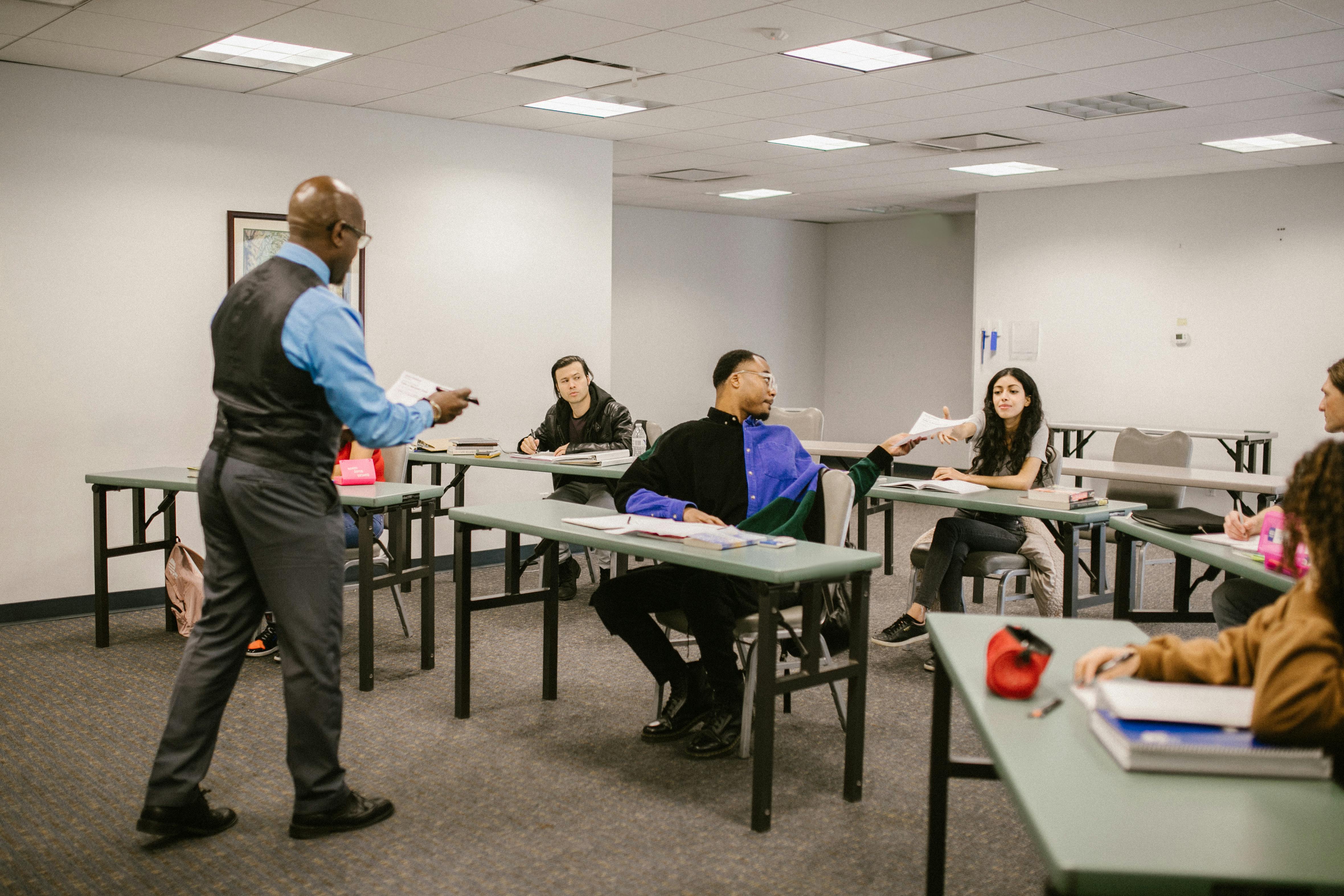In today’s fast-paced academic environment, mastering how to do a presentation in class is more important than ever. Whether you’re pitching a research project, summarizing a case study, or leading a group discussion, a well-executed student presentation can leave a lasting impression on both your peers and instructors. Beyond simply reciting facts, an effective classroom presentation demonstrates your ability to organize ideas clearly, engage an audience, and communicate with confidence. It’s not just about the slides you prepare—it’s about the connection you build, the clarity you achieve, and the enthusiasm you convey. This blog series will guide you step by step through the essentials of preparing and delivering a compelling presentation in a classroom setting.
What is a Presentation?
A presentation is a structured way of sharing ideas, research, or arguments with an audience through both spoken words and visual support. For you as a student presenter, it’s an opportunity to demonstrate not only what you know, but also how well you can communicate, persuade, and engage your classmates.
Common Formats
- Slide Decks (e.g., PowerPoint or Google Slides): The most familiar format, combining bullet points, images, charts, and sometimes embedded videos.
- Posters and Infographics: Visual summaries printed or displayed on a board—ideal for highlighting key data, processes, or comparisons at a glance.
- Live Demonstrations: Showing an experiment, prototype, or software in action, which can be particularly effective for STEM subjects.
- Handouts or Printed Reports: Supplementary materials that classmates can follow along with or take away for deeper study.
- Multimedia Presentations: Incorporating audio clips, animations, or short film segments to bring concepts to life.
Why Students Give a Presentation in Class
The University requires students to give in-class presentations designed to test and deepen their understanding of the subject matter and to foster deeper learning through the active construction and dissemination of knowledge. The process of preparing a presentation develops students’ critical thinking and problem-solving skills. Post-presentation feedback provides valuable learning opportunities, helping students recognise shortcomings and expand their perspectives. In addition, college presentations simulate many of the communication scenarios required by careers, preparing students for their future careers and effectively boosting their self-confidence.
As a student, mastering the art of presentation empowers you to stand out academically and professionally—so let’s continue by exploring why this skill is so vital for your growth.

Why You Should Learn How to Give a Presentation in Class
Mastering the art of classroom presentation is an invaluable skill for university students, extending far beyond simply delivering information. It’s a cornerstone of academic success and a crucial stepping stone towards future professional endeavors. Why is this skill so vital? Let’s delve into some key reasons.
Enhancing Communication and Expression Skills
Presenting in class provides a practical platform to hone your communication abilities. It forces you to articulate complex ideas clearly and concisely, tailoring your message to your audience – your peers and instructors. This process refines your verbal fluency, strengthens your ability to explain concepts effectively, and teaches you how to engage an audience through your delivery.
Strengthening Logical Thinking and Structuring Abilities
Crafting a compelling presentation demands a logical flow of information. You must organize your thoughts, structure your arguments coherently, and present evidence in a persuasive manner. This exercise naturally enhances your logical thinking and your capacity to build well-structured narratives, skills that are transferable to essay writing, research papers, and problem-solving in various academic disciplines.
Cultivating Confidence and Stage Presence
Standing in front of your peers and delivering a presentation can be daunting initially. However, with each presentation, you gain confidence in your ability to speak publicly and manage any nervousness. You learn how to project your voice, maintain eye contact, and use body language effectively, developing a stronger stage presence that will benefit you in countless future situations.
Practical Applications in Academia and the Workplace
The skills honed through classroom presentations have direct relevance in both your academic journey and your future career. In academic settings, you’ll likely need to present research findings, project proposals, and group work. In the professional world, presentation skills are essential for job interviews, team meetings, client pitches, and sharing your expertise. By mastering classroom presentations, you are actively preparing yourself for these real-world demands, giving you a significant advantage as you progress through your studies and beyond.
How to Prepare a Good Presentation in Class
Clarifying the target and audience
Before you start crafting slides, clarify what you want your classmates to take away. Is your goal to inform, persuade, or spark discussion? Identify one or two key messages and tailor your content to your audience’s level of knowledge and interests. For instance, if your peers are unfamiliar with the topic’s technical aspects, plan to introduce basic concepts before diving deeper.
Content gathering and outline building
Gather information from credible sources—textbooks, peer‑reviewed articles, reputable websites, and lecture notes. As you collect facts and examples, begin building an outline to keep your ideas organized and ensures a logical flow:
- Introduction: Hook, context, and thesis statement
- Main Points: Two to four subtopics, each supported by data or anecdotes
- Conclusion: Recap and call to action or reflection
Design Slide
- Simplicity and focus:Limit each slide to a single idea or data point. Too much text overwhelms; aim for short bullet points or single-sentence headlines.
- Visual aids:Use charts, diagrams, and high‑quality images to reinforce key points. Visuals not only break monotony but also help classmates retain information.
- Text layout:Choose legible fonts at a size no smaller than 24 pt. Maintain consistent line spacing and alignment. Use whitespace strategically to guide the eye and prevent clutter.
- Multimedia elements:Embed brief video clips or subtle animations to illustrate dynamic processes or case studies. Keep these multimedia snippets under 30 seconds to maintain pacing.
Rehearsal and time control
Rehearse in a setting similar to your classroom—stand up, speak aloud, and advance slides as you would live. Time each section of your presentation; aim to finish a few minutes early to allow for questions. Record yourself on a phone or webcam to spot areas for improvement, such as filler words, pacing issues, or distracting gestures. Regular practice builds muscle memory and reduces stage fright, ensuring your actual delivery feels confident and polished.

How to Do a Presentation in Class
Opening
A strong opening sets the tone for your student presentation. Start with a hook—such as a surprising statistic, a brief story, or a provocative question—that relates directly to your topic. Introduce yourself and state your purpose clearly: “Today, I’m going to show you how effective time management can improve your study habits.” This roadmap prepares your classmates for what’s coming and establishes your credibility.
Presentation of the main content
Organize the body of your presentation into two to four main points, each introduced by a clear header slide or transition phrase. For example: “First, let’s explore…” Use concise bullet points and support each point with evidence—charts, quotes from experts, or brief anecdotes. When moving from one section to the next, use transition sentences like, “Having understood the challenges, let’s now consider possible solutions.” This structure helps your audience follow your logic and retain key information.
Presentation skills
- Voice Control: Vary your pitch and pace; slow down on complex ideas and pause briefly after important statements.
- Eye Contact: Scan the room rather than fixating on your slides or notes; this builds rapport and keeps classmates engaged.
- Body Language: Stand with a relaxed posture, use open gestures to emphasize points, and avoid pacing or fidgeting.
- Handling Nerves: Practice deep breathing before you begin, and remember that occasional pauses are natural. If you lose your place, take a sip of water or glance at your slide titles to regain focus.
Interaction and questions
Encourage participation by embedding quick activities: ask a rhetorical question, prompt a show of hands, or use a one‑minute poll (via an online tool or simple paper cards). When fielding questions, listen fully before responding, repeat the question to ensure everyone hears it, and answer concisely. If you don’t know the answer, be honest: offer to do further research and follow up after class. This approach shows humility and professionalism.
Things to do after the presentation
Once you conclude with a clear summary and call to action, invite feedback. Distribute a short survey form or ask classmates for one suggestion each. After class, reflect on what went well and where you stumbled—note your timing, audience reactions, and any technical hiccups. Finally, review the feedback to identify areas for improvement, whether it’s tightening your slides, refining your delivery, or engaging more effectively. This continuous loop of practice, performance, and reflection is the key to mastering how to do a presentation in class.
Common Pitfalls and Tips of Doing Presentation
Even the most prepared student presentation can stumble when common mistakes crop up. By recognizing these pitfalls in advance, you can steer clear of them and deliver a smoother, more engaging talk.
- Information Overload
- Pitfall: Cramming too many facts or bullet points onto each slide overwhelms your classmates and dilutes key messages.
- Tip: Stick to one main idea per slide. If you have more to say, split content into separate slides or use handouts for detailed data.
- Reading Directly from Slides
- Pitfall: Verbally repeating text that’s already on the screen makes your delivery redundant and disengaging.
- Tip: Use slides as prompts or visual accents, not scripts. Speak in your own words and expand on the bullet points to add value.
- Neglecting Audience Engagement
- Pitfall: A monologue-style presentation turns classmates into passive listeners who may zone out or lose interest.
- Tip: Incorporate questions, quick polls, or brief activities. Even a simple “raise your hand if…” invites participation and keeps energy high.
- Inconsistent Design and Formatting
- Pitfall: Mismatched fonts, erratic colour schemes, and uneven alignment make slides look unprofessional.
- Tip: Choose one or two complementary fonts and a consistent colour palette. Align text and images uniformly, and maintain equal margins across all slides.
- Insufficient Practice
- Pitfall: Under-rehearsed presenters often misjudge timing, stumble over transitions, or freeze when technical glitches occur.
- Tip: Rehearse your full presentation at least three times—once for content mastery, once for timing, and once under simulated conditions (with slides and any multimedia).
- Ignoring Technical Preparation
- Pitfall: Last-minute software updates, incompatible file formats, or failing hardware can derail your flow.
- Tip: Test your presentation on the actual classroom equipment in advance. Have backup copies on a USB drive or cloud storage, and bring any necessary adapters or cables.
- Poor Handling of Questions
- Pitfall: Evading questions or answering defensively undermines your credibility.
- Tip: Listen fully, paraphrase the question to confirm understanding, and answer concisely. If uncertain, admit it and offer to follow up with a researched response.
By anticipating these common missteps and applying the corresponding tips, you’ll be better equipped to deliver a confident, polished, and effective how to do a presentation in class. Remember: every glitch is a learning opportunity—reflect on what went wrong, adjust your strategy, and your next presentation will be even stronger.

Conclusion
In summary, mastering how to do a presentation in class involves careful preparation, clear organization, and engaging delivery. By defining your objectives and audience, researching thoroughly, and structuring your content with a logical outline, you set the foundation for success. Thoughtful slide design—focused on simplicity, visuals, and readable text—enhances your message without overwhelming classmates. During your presentation, use strong openings, smooth transitions, and effective voice and body language to maintain attention. Encourage interaction through questions or activities, and handle queries with composure. Finally, reflect on feedback and rehearsal insights to continually refine your skills. As you practice these steps, your confidence will grow, making each student presentation more polished and impactful. Embracing this process not only elevates your classroom performance but also equips you with communication abilities that will serve you well throughout your academic and professional journey.
If you’re thinking about studying in the UK, it’s crucial to find the right student accommodation. That’s where uhomes.com comes in. It’s a reliable platform that helps students like you find the perfect place to live in London, Manchester, Glasgow, Cardiff, Birmingham and many other cities. So far, they’ve helped more than 55,000 students successfully find their dream homes.

FAQ
How to start a presentation in a class?
Begin with a hook that captures attention—this could be a surprising statistic, a brief anecdote, a thought‑provoking question, or even a short video clip. After your hook, introduce yourself (“Hello, I’m [Name] from [Course/Year]”) and state your presentation’s purpose: “Today I’ll show you how X impacts Y.” Finish your opening by outlining your roadmap in one or two sentences: “First we’ll explore A, then B, and finally C.” This sequence—hook, self‑intro, purpose, roadmap—sets clear expectations, builds rapport, and signals to your classmates what they’ll learn.
What are the 5 basic steps of presentation?
- Plan & Research: Define your objective, analyze your audience, and gather credible information.
- Organize & Outline: Create a logical structure: introduction, main points (2–4), and conclusion.
- Design Visuals: Build slides or materials that are clear, focused, and visually engaging.
- Rehearse & Refine: Practice delivery with timing, smooth transitions, and simulated Q&A.
- Deliver & Follow Up: Present confidently, interact with the audience, handle questions, and gather feedback afterward for improvement.
What is the 5‑5‑5 rule for presentation?
The 5‑5‑5 rule helps maintain slide simplicity and clarity:
- 5 words per line
- 5 lines per slide
- 5 bullet points maximum per slide
By adhering to these limits, you avoid text overload, ensure readability from the back of the room, and force yourself to speak extemporaneously rather than reading slides verbatim. This keeps classmates engaged and focuses attention on your verbal explanations and storytelling rather than dense text.
How can I be good at presenting in class?
- Know Your Material: Master your content so you can speak naturally without relying heavily on notes.
- Practice Regularly: Rehearse aloud, record yourself, and time each section to build confidence.
- Engage Your Audience: Vary tone and pace, make eye contact, and invite participation through questions or quick polls.
- Use Clear Visuals: Support your points with simple slides—avoid clutter and highlight key data with charts or images.
- Manage Nerves: Breathe deeply before starting, focus on your message rather than on yourself, and remember that occasional pauses are okay.
- Seek Feedback: After each presentation, ask peers or instructors for one strength and one improvement area.
What is a good opening sentence for a presentation?
A strong opening sentence grabs attention and sets the stage. Examples include:
- “Did you know that over 70% of students report anxiety before speaking in class?”
- “Imagine a world where smartphones make up half of all classroom distractions—today we’ll explore how to turn that distraction into a learning tool.”
- “When I first heard about [topic], I couldn’t believe its impact—let me share what I discovered.”
- Choose an opening that aligns with your topic and audience, then smoothly transition into your self‑introduction and purpose.








